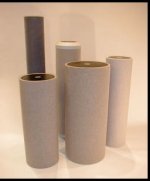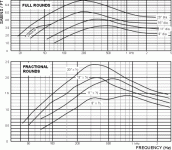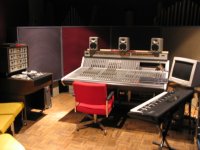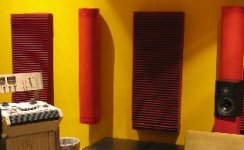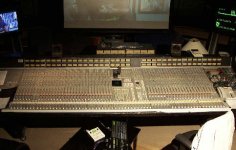I had to move my testing, for the time being, into a small room, 12wx18wx7H and am having trouble getting the response flat from 1khz down to 31.5hz.
The trouble spot is around 50 and 40 hz areas, down 10db from 1khz spl. 31.5hz spl is the same as 1khz. Other than those two frequencies, the response is within +2.5db -3.5db from 1khz to 31.5hz.
Any ideas?
The trouble spot is around 50 and 40 hz areas, down 10db from 1khz spl. 31.5hz spl is the same as 1khz. Other than those two frequencies, the response is within +2.5db -3.5db from 1khz to 31.5hz.
Any ideas?
Throwing a dead cat in a room usually improves acoustics, almost never hurts.
There are people making a living that way (except they sell ultra-foam and super-fiber absorbers; no profit in dead cats).
No precision needed: Most rooms will be "better", at least different, with any reasonable number of dead cats added.
For 40Hz troubles you need BIG dead cats.
You want absorption more than 4" 100mm thick, and preferably more like 12" 300mm thick.
Bring in as many over-stuffed chairs and sofas as you can.
When you need to suck-up bass: dead cats in corners are better than laying in the middle of the floor.
Two layers of fiberglass attic insulation 6" thick to make a 15"*12" 380mm*300mm batt, jammed into each corner from floor to ceiling, will damp most rooms' bass. In your low long room, you may need to damp one or both of the 12' and 18' long-corners, probably at the wall-ceiling corner.
There are actually ways to calculate all this. You probably have bass waves the same length or width as the room, so it works like a pipe organ for 2 or 3 notes. It would be nice to damp JUST those notes without affecting others. But tuned absorbers are very tricky. And broadband absorbers don't work at bass unless they are thick, but do have a very broadband effect. Emphasize the bass absorption by using a small area (less than 20% of total room surface area) of thick (10" or more) fuzz jammed in corners. You may need very little of it to kill the resonance at 40 and 50, and maybe not enough to significantly change the 100-1,000 response.
There are people making a living that way (except they sell ultra-foam and super-fiber absorbers; no profit in dead cats).
No precision needed: Most rooms will be "better", at least different, with any reasonable number of dead cats added.
For 40Hz troubles you need BIG dead cats.
You want absorption more than 4" 100mm thick, and preferably more like 12" 300mm thick.
Bring in as many over-stuffed chairs and sofas as you can.
When you need to suck-up bass: dead cats in corners are better than laying in the middle of the floor.
Two layers of fiberglass attic insulation 6" thick to make a 15"*12" 380mm*300mm batt, jammed into each corner from floor to ceiling, will damp most rooms' bass. In your low long room, you may need to damp one or both of the 12' and 18' long-corners, probably at the wall-ceiling corner.
There are actually ways to calculate all this. You probably have bass waves the same length or width as the room, so it works like a pipe organ for 2 or 3 notes. It would be nice to damp JUST those notes without affecting others. But tuned absorbers are very tricky. And broadband absorbers don't work at bass unless they are thick, but do have a very broadband effect. Emphasize the bass absorption by using a small area (less than 20% of total room surface area) of thick (10" or more) fuzz jammed in corners. You may need very little of it to kill the resonance at 40 and 50, and maybe not enough to significantly change the 100-1,000 response.
"polycylindrical diffusers"...
Try doing a Google search on "polycylindrical diffusers"... Did I just hear someone grown?
These can be quite effective in reducing LF resonance while not killing the all of the HF.
Filling them with dead cats for dampening material works well too.
A word of caution about fiberglass insulation, in addition to making you scratch like a monkey for a few days after installing it, it has been known to cause respiratory distress. It seems those little jagged edges can really mess with your lungs too. Rigid duct liner is a black fiberglass material that has less *****ly edges. Its still a beast to handle but it wont make your lings hurt.
I’ve hung rigid duct liner behind a throw rug using heavy duty curtain hangers. Leaving a dead space (about 4") between the 2" duct liner and the wall seemed to do well at reducing low frequency resonance.
Of course being that this subject is posted in the tube column, you could think about using some sonotube for homebrew tube-traps too.
Lots of acoustics threads floating around lately. Perhaps we have the basis of a new forum topic brewing?
Try doing a Google search on "polycylindrical diffusers"... Did I just hear someone grown?
These can be quite effective in reducing LF resonance while not killing the all of the HF.
Filling them with dead cats for dampening material works well too.
A word of caution about fiberglass insulation, in addition to making you scratch like a monkey for a few days after installing it, it has been known to cause respiratory distress. It seems those little jagged edges can really mess with your lungs too. Rigid duct liner is a black fiberglass material that has less *****ly edges. Its still a beast to handle but it wont make your lings hurt.
I’ve hung rigid duct liner behind a throw rug using heavy duty curtain hangers. Leaving a dead space (about 4") between the 2" duct liner and the wall seemed to do well at reducing low frequency resonance.
Of course being that this subject is posted in the tube column, you could think about using some sonotube for homebrew tube-traps too.
Lots of acoustics threads floating around lately. Perhaps we have the basis of a new forum topic brewing?
Attachments
About this "dead-cat" issue. Mine are alive and are therefore "mobile" sound absorbers. Keeps things interesting...
Now, as far as bass traps are concerned. We have been building quite a few of them ourselves. Look for cardboard "concrete" tubes from Home Despot (sic!), they come in diameters up to 12", I think, all are four feet long. Stuff these with the new "Miraflex" fiberglass insulation from Owens-Corning (usually a special order item). This stuff is SO much easier to work with than the regular stuff - no itch (in fact, part of its advertising) - and it is comparable to cotton in a perforated plastic wrap. Step 3: cover the tube with nice fabric or paint. The tube itself as a Helmholtz is most effective at its resonance frequency (diameter!!), and the "stuffing" will broaden its effective trapping range. Use different size tubes for different bass "center" frequencies - similar to organ pipes.
Price for DIY: about $ 10 per tube - or you can buy a similar item from Tubetraps for about $ 200/ each - your choice.
PS: If you need high frequency absorption, wrap the tubes with some foam before you cover them with fabric.
Alternative:
get a few old futons and use them rolled up with a cover in corners
Cheers

Now, as far as bass traps are concerned. We have been building quite a few of them ourselves. Look for cardboard "concrete" tubes from Home Despot (sic!), they come in diameters up to 12", I think, all are four feet long. Stuff these with the new "Miraflex" fiberglass insulation from Owens-Corning (usually a special order item). This stuff is SO much easier to work with than the regular stuff - no itch (in fact, part of its advertising) - and it is comparable to cotton in a perforated plastic wrap. Step 3: cover the tube with nice fabric or paint. The tube itself as a Helmholtz is most effective at its resonance frequency (diameter!!), and the "stuffing" will broaden its effective trapping range. Use different size tubes for different bass "center" frequencies - similar to organ pipes.
Price for DIY: about $ 10 per tube - or you can buy a similar item from Tubetraps for about $ 200/ each - your choice.
PS: If you need high frequency absorption, wrap the tubes with some foam before you cover them with fabric.
Alternative:
get a few old futons and use them rolled up with a cover in corners
Cheers

Tube traps for the Mason Hall studios? But Jeesh that rooms so big I cant imagine it needing much LF treatment (just move the bass drum around abit)
My cats are fat and happy too.
I think its the length of the tube that effects the resonant frequency with the diameter effecting the amplitude that they resonate at.
-Dave
My cats are fat and happy too.
I think its the length of the tube that effects the resonant frequency with the diameter effecting the amplitude that they resonate at.
-Dave
This company has been very popular with acoustic device manufactures. Its not uncommon to see them listed as the reference for standard color options. Ypholstery fabrics work well also.
http://www.guilfordofmaine.com/
I think if I were playing around with tube traps these days that I would think about trying to extend there response by cutting slots in the side of the sono-tube with a router and by sing some kind of a limp mass (heavy rubber or vinyl) inside of the tube.
The commercial tube traps always struck me as having a wire coating over the tube, under the fabric. I always wanted to take one apart to see what magic they pack inside, but was always afraid of what would happen if all the trapped tubes got loose from the inside.
The Owens Miramax insulation sounds great. Ill need to check it out.
http://www.guilfordofmaine.com/
I think if I were playing around with tube traps these days that I would think about trying to extend there response by cutting slots in the side of the sono-tube with a router and by sing some kind of a limp mass (heavy rubber or vinyl) inside of the tube.
The commercial tube traps always struck me as having a wire coating over the tube, under the fabric. I always wanted to take one apart to see what magic they pack inside, but was always afraid of what would happen if all the trapped tubes got loose from the inside.
The Owens Miramax insulation sounds great. Ill need to check it out.
Will one of these cylindrical tube traps really be effective at 25Hz, assuming it is sized appropriately? I have a +6dB resonance at 25Hz, perhaps 1/10 octave ewide. Very problematic to EQ.
Maybe I just need a couch along the back wall of my room. ^_^
Hmm, are we talking some 35" wide tube at these f? I think the SAF is definitely down to zero.
Maybe I just need a couch along the back wall of my room. ^_^
Hmm, are we talking some 35" wide tube at these f? I think the SAF is definitely down to zero.

25Hz, well thats about 22 feet long?
1/2 wave would be round 11 feet, and a 1/4 wave would be about 6.5 feet.
Do any of these dimensions seem familiar in your room?
A 6.5 foot chunk of stuffed sono-tube would be a cheap experiment. The biggest trick I can see would be positioning it to optimize its resonance with the room mode.
1/2 wave would be round 11 feet, and a 1/4 wave would be about 6.5 feet.
Do any of these dimensions seem familiar in your room?
A 6.5 foot chunk of stuffed sono-tube would be a cheap experiment. The biggest trick I can see would be positioning it to optimize its resonance with the room mode.
Indeed, my room is narrow (10-15', varies) but long (~22'). It is conceivable that there is reinforcement of the major axis. I have a minor problem at 42Hz but EQ alone fixes that.
I am pretty sure that there is a local maxima at the rear wall, low bass is nearly 10dB higher there than at the listening position. I don't even need to look at the meter, I can feel the difference! Seems like a great place for the traps?
Doesn't the tube need to be wider as well, for lower frequencies? Thanks for the info.
I am pretty sure that there is a local maxima at the rear wall, low bass is nearly 10dB higher there than at the listening position. I don't even need to look at the meter, I can feel the difference! Seems like a great place for the traps?
Doesn't the tube need to be wider as well, for lower frequencies? Thanks for the info.
I think that the diameter of the tube will affect the amplitude that it will resonate at. The stuffing will help to crate a broader range of amplitude. If the tube is too fat, I think it will be tough to excite it.
How big around is an 11-foot organ pipe?
Do you think it might make any sense to place the trap(s) behind or near the speaker/sub?
Any issues with WAF and big round things cluttering up the room.
There may also be some wall treatments (like poly cylindrical diffusers, different from a tube trap) that could be used to discourage the creation of LF standing waves.
I actually only brought up tube traps because I thought it would be funny, in an ironical sort of way, to discuss them in the tube forum.
How big around is an 11-foot organ pipe?
Do you think it might make any sense to place the trap(s) behind or near the speaker/sub?
Any issues with WAF and big round things cluttering up the room.
There may also be some wall treatments (like poly cylindrical diffusers, different from a tube trap) that could be used to discourage the creation of LF standing waves.
I actually only brought up tube traps because I thought it would be funny, in an ironical sort of way, to discuss them in the tube forum.
Da5id4Vz said:
I think its the length of the tube that effects the resonant frequency with the diameter effecting the amplitude that they resonate at.
-Dave
Well, yes - if we are speaking of organ pipes per se. But in this case it depends if you fit in the wave lengthwise or widthwise, plus all the broadening from the stuffing... From the tubetrap response curves you can see the effect of diameter on the bass dampening.
The Home Despot tubes are for the control rooms. You can hang them in less conspicuous places, but you are right: for 25 Hz you WILL need large diameter and long tubes. Perhaps best to think of another (adjacent) room as a bass trap and allow for some sort of coupling between the rooms (openings).
Oh, one more thing, just thinking out load here: how about the idea of the "infinite baffle" ? Ie. think of a roll-up transmission line with ductliner to tranfer the wave's energy into heat. Now for a long room with low frequency problems I could imagine that thing to look like a long snail in the back of the room with the broad opening facing the width of the room- see the B&W Nautilus.
Cheers
Attachments
Da5id4Vz said:I actually only brought up tube traps because I thought it would be funny, in an ironical sort of way, to discuss them in the tube forum.
Yes, I found that amusing.
It looks like diameter affects efficiency and the center frequency of the absorbtion for a given length. Is there a corresponding graph of tube length to absorbtion? I wonder because these commercial and DIY designs seem to apply segmented architectures (e.g. 3' segments) While this would be ideal for a broad-band absorber, if all we want is a specific (LOW!) frequency, would a continuous long tube be better?
I know that placement can be very counterintuitive, but I've found that lower bass is actually quite a bit louder at the back wall (12' away) than 1.5' from the sub (which is along a wall, not corner loaded). Wouldn't the best place for an absorber be at a point where bass reinforcement is high?
Moved again
I just got my testing room moved again and now I am in a 12' x 20' x 8-10' slanted ceiling. Had to start all over again and as before, positioned speakers/listening position to lessen the low bass resonances, but got one at mid to high bass. Will take suggestions and see what I come up with.
For a long time I had approx. 20' x 30' x 7' room to work in, but landlord needed it for something else. Problems seemed much less in intensity then, at least seemed easier to work with.
Thanks for all your help guys. Have a great Chrismas.
I just got my testing room moved again and now I am in a 12' x 20' x 8-10' slanted ceiling. Had to start all over again and as before, positioned speakers/listening position to lessen the low bass resonances, but got one at mid to high bass. Will take suggestions and see what I come up with.
For a long time I had approx. 20' x 30' x 7' room to work in, but landlord needed it for something else. Problems seemed much less in intensity then, at least seemed easier to work with.
Thanks for all your help guys. Have a great Chrismas.
> diameter of the tube will affect the amplitude that it will resonate at.
No.
As BG says, that may seem true in organ pipes.
Length mainly affects frequency.
Diameter, or really the length/diameter ratio, affects the Q (relative bandwidth) of the resonance.
Take a pipe 22' long and 22' diameter. It will hardly resonate at all.
A toilet paper tube (length/diameter about 4:1) has a slight resonance, very broad. Hold it to your ear and hear what you hear.
A flute runs about 30:1 length/diameter and has a strong resonance, yet not so narrow that it can't be "pulled" or "lipped" off pitch by a trained player.
Put a 20 foot garden hose to your lips and play it like a trumpet. Length/diameter is about 300:1. You may be able to play it, but you can't "pull" it, very narrow resonance.
For acoustic control, length/diameter ratios from 3:1 to 20:1 are useful depending if you need broad or narrow absorption.
No.
As BG says, that may seem true in organ pipes.
Length mainly affects frequency.
Diameter, or really the length/diameter ratio, affects the Q (relative bandwidth) of the resonance.
Take a pipe 22' long and 22' diameter. It will hardly resonate at all.
A toilet paper tube (length/diameter about 4:1) has a slight resonance, very broad. Hold it to your ear and hear what you hear.
A flute runs about 30:1 length/diameter and has a strong resonance, yet not so narrow that it can't be "pulled" or "lipped" off pitch by a trained player.
Put a 20 foot garden hose to your lips and play it like a trumpet. Length/diameter is about 300:1. You may be able to play it, but you can't "pull" it, very narrow resonance.
For acoustic control, length/diameter ratios from 3:1 to 20:1 are useful depending if you need broad or narrow absorption.
It seems I have had this wrong for some time now.
Thanks for the explanation it makes it very intuitive to It seems I have had this wrong for some time now.
Thanks for the explanation it makes it very intuitive to understand. Wish Id asked you years ago instead of wallowing in my organ tube. (yikes)
Who is BG? Is that our fine furry friend in Fredonia?
I think tiroth is correct that placing his trap at the maxima of the wave will get him the best affect, but I remember you cautioning about the use of narrowband traps. The comfy chair solution might be less sonically intrusive.
Positron, Interesting new room. Is the ceiling drywall or acoustic suspended tile?
I have seen photos of some nice mastering rooms that start out as essentially rectangular. Its tough to tell in this photo but Gateway Mastering has one room that is essentially rectangular with large wedge shaped traps on the walls and ceiling. Might not be a bad idea for your space. Check out the 1" 2 track machine in the picture too, its a monster!
(spell check is my friend)
http://www.gatewaymastering.com/masttech.asp
Thanks for the explanation it makes it very intuitive to It seems I have had this wrong for some time now.
Thanks for the explanation it makes it very intuitive to understand. Wish Id asked you years ago instead of wallowing in my organ tube. (yikes)
Who is BG? Is that our fine furry friend in Fredonia?
I think tiroth is correct that placing his trap at the maxima of the wave will get him the best affect, but I remember you cautioning about the use of narrowband traps. The comfy chair solution might be less sonically intrusive.
Positron, Interesting new room. Is the ceiling drywall or acoustic suspended tile?
I have seen photos of some nice mastering rooms that start out as essentially rectangular. Its tough to tell in this photo but Gateway Mastering has one room that is essentially rectangular with large wedge shaped traps on the walls and ceiling. Might not be a bad idea for your space. Check out the 1" 2 track machine in the picture too, its a monster!
(spell check is my friend)
http://www.gatewaymastering.com/masttech.asp
Attachments
Da5id4Vz said:Who is BG? Is that our fine furry friend in Fredonia?
Yup. I dug out a picture of some of our smaller control rooms: "Miles" and "Coltrane". Notice the "real" organs in the back - these were former organ practice rooms. We keep them for decoration (sigh).
Attachments
Actually, it is a Scully 1/2" four track. We just recapped and relapped it. 
Oh, and here our new Control A, housed in our new facilities. Sorry, no tubes, OK, I'll stop the photoshow now.
OK, I'll stop the photoshow now.
Dave, do you ever wonder how Bob Ludwig can hear anything with all the stuff in front of the speakers?
BTW, PRR - what is your opinion of the Yamaha P 2200? I have one coming and I am wondering how to improve it with DIY modifications.
Cheers
Oh, and here our new Control A, housed in our new facilities. Sorry, no tubes,
Dave, do you ever wonder how Bob Ludwig can hear anything with all the stuff in front of the speakers?
BTW, PRR - what is your opinion of the Yamaha P 2200? I have one coming and I am wondering how to improve it with DIY modifications.
Cheers
Attachments
- Status
- This old topic is closed. If you want to reopen this topic, contact a moderator using the "Report Post" button.
- Home
- Amplifiers
- Tubes / Valves
- Room resonances
